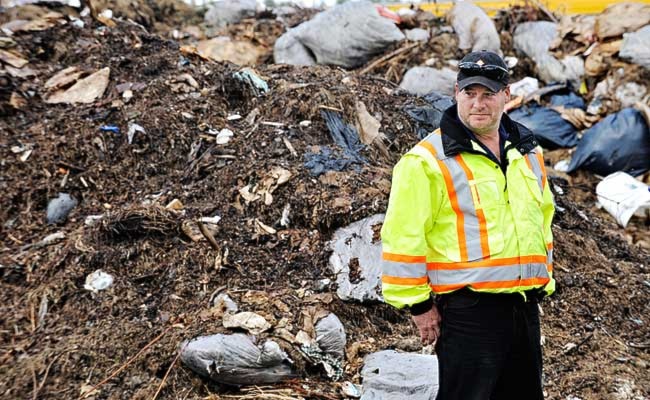Landfill manager Dan Jordan likens composting to baking a cake.
It’s a strange analogy when you consider what’s cooking away at the city’s landfill is far from edible.
At the compost facility, waste is piled in heaps the length of a street block.
Banana peels and apple cores mingle with fish bones and grass clippings.
The smell wafts high into the air, a ripe stench that attracts hordes of flies and flocks of seagulls.
On this particular day the odour is similar to fermenting oranges and rotting onions.
It’s hard to imagine this pile of decomposing fruits and vegetables turning into rich, black compost.
However, this week the city announced it will start selling the compost that’s been cooking away at their landfill for years.
The process of transforming waste into sellable compost is complex, said Jordan, explaining how food scraps are turned into soil.
When the compost is especially smelly, nitrogen and carbon levels are out of whack, he said.
Carbon to nitrogen levels should be 30 to 1, that’s when compost smells like a forest floor.
“Composting is kind of like baking a cake,” he said.
“You have to use your nose - if it doesn’t smell good, chances are, it isn’t.”
Garret Gillespie, who also oversees the compost at the city’s landfill, prefers to use a farming analogy.
Problems arise if “farmers” aren’t properly attending to the waste, said Gillespie who refers to himself as a “compost freak.”
Compost is full of living organisms called thermophiles that are busy chomping away at the food scraps people throw into their green bins.
“We have to make sure our livestock are fed and watered at all times,” he said.
That means giving the compost certain “foods” that will help in the biodegrading process. Gillespie adds minerals from rocks to help balance the diet of the thermophiles so they can reach their biological potential.
He also applies a special compost “tea” to accelerate the composting process.
The mixture varies, but usually contains water, molasses and litter from the forest floor.
The first batch of compost the landfill churned out didn’t have enough fungi in it, said Gillespie. He needs to keep rigid records of what is added and how long the compost sits.
Fresh compost collected from people’s green bins arrive at the facility four times a week.
After adding woodchips to balance the amount of carbon in the mixture, the compost is watered and put through a grinder.
Then it sits for several weeks cooking at about 65 degrees Celsius, a temperature naturally reached through the composting process.
“The heat is the only thing that adequately kills off pathogens and pesticides,” said Gillespie reaching his hand into one of the piles of compost and pulling out a steaming clump of waste.
Afterwards its treated with compost tea and a windrow machine. Then it’s ready to be put through an industrial double-sifter, a machine that looks like a giant hand-held Parmesan grater.
What comes out on the other end is a rich, dark soil ready to be bagged and sold. The whole process takes about 12 months.
The city has been accepting compost for the last 10 years, but only recently has it had the capability to transform the piles of rotting vegetables and fruit into sellable compost.
Last year, the city stepped up production at the landfill when it introduced its green cart program to collect compost from around the city.
Now the city estimates that about 42 per cent of all city waste is being diverted to the compost facility rather than the landfill. It’s a number that could be almost twice as high if people paid more attention to where they toss their waste, said Gillespie.
At the same time, sorting out garbage not meant to be composted is one of the biggest problems at the facility, said Gillespie.
Crews have found everything from computers and printers to jackets, shoes, Christmas lights and car motor parts tossed into the city’s green bins.
“Sometimes things don’t get sorted out before they go into the tub grinder and we’ll spend two hours fixing the grinder,” said Jordan.
But the biggest headache is plastic.
For every truckload of fresh soil, the landfill’s double sifter spits out an almost equal amount of plastic, said Gillespie.
Even so-called compostable plastic doesn’t always break down.
Gillespie has found compostable bags years after they’ve been dropped off at the landfill. They’re in good enough shape that you could actually still carry things in them, he said.
Frustrated by the amount of plastic city crews were pulling out of the compost, Gillespie patched together a “plastic super-sucker” over the winter using salvaged metal and a motor from an old city street sweeper.
The super-sucker has a vacuum-like hose that sucks out 70 per cent of the plastic from the compost.
It’s up to the double-sifter to take out the rest.
The compost that comes out on the other end is better quality than what people can buy in stores, said Gillespie.
A lot of material being sold in garden stores is willfully misrepresented as organic compost, he said.
“There’s no enforced regulations for selling compost in a retail setting,” said Gillespie.
“Basically you can bag anything and sell it as compost
“People want to do the right thing and they buy it - but they’re getting scammed.”
The city is working to certify their compost as organic by next year. If this happens, Whitehorse will be the first city in Canada to do so.
Before that can happen more rigorous record-keeping needs to happen, said Gillespie.
He’s hoping that will come as early as next year.
For now, people can start purchasing the compost as soon as next week, pending a decision from council at their Monday meeting.
The 25 litre bags will sell for $5 and will come in re-usable burlap bags. They can be picked up from the city’s landfill office.
Contact Vivian Belik at
vivianb@yukon-news.com
